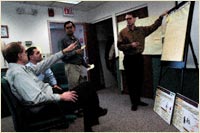|
Here are just some of the associated skills and approaches
your team will experience and develop by participating in our workshops:

Enhance cross-functional
team effectiveness
Create the cultural
climate that taps into the range of skills and expertise found in
multi-disciplinary teams. This leads to improved problem identification
and solving and better organizational alignment.
Develop the capability
to develop discovery insights to inform innovation direction
Explore customer
needs, emerging technology and capabilities, and market drivers to create a body of knowledge that will drive innovation strategy
and increase the effectiveness of your innovation system.
Learn the art of the
interview and let the customer tell their story using open-ended,
projective and other best practice techniques
Allow the team to go
deeper in their "mind of the customer" and the customer's
environment to understand not just what they say they do but what their
values, perceptions, and true behaviors are. Get
beyond their existing filters and viewpoints and truly hear customer needs
from a perspective that enables breakthrough thinking.
Take a data-driven
approach to reveal the patterns in the broader innovation
environment rather than shooting from the hip or working off of gut feel
Let the data shape
team thinking and develop the story about the customer, technology, and
the marketplace. Set aside existing, and often internally derived mental
models that limit innovation. Open the organization up to
discovering new insights. We call this a bottom up or grounded approach.
Use highly effective
team and organizational learning processing to create shared
understandings enhancing innovation
Enable the team to tap
into their underlying creativity and expertise while creating a shared
mental model that aligns the organization and focuses solution
development and implementation.
Separate problem
identification from solution development
First define the full range
of problems (customer needs, limiting capabilities, barriers to market
success). Then selectively work on the most important to develop solutions.
This leads to increased innovation success rates and more efficiently
uses limited resources.
Use divergent and
convergent processes during concept development, select ideas for newness and
excitement, then Work to
build in feasibility.
Allow the team to
create and develop exciting solutions that are new to the company and
new to the market. This increases the strength and value of the
opportunities.
Use developmental
thinking vs. decision making early in the innovation process
Ensure the team has
a safe environment from which they can think out of the box, take risks,
and offer new ideas that may not be well developed yet. Then shape
and refine those ideas to a level of development where they can be
fairly judged on their own merits and enter the innovation pipeline
process.
Establish clear roles and responsibilities with
appropriate charters and resources
Allow the
cross-functional team to focus on their innovation goals rather than
side agendas, or slowed down by silo thinking. Create a core team
with leadership responsibilities and true innovation decision making
authority.
Establish extended
team resources internal and external to the organization to add to the
collective skills and knowledge of the team when needed.
Leverage key leaders
and stakeholders to do the blocking and tackling protecting the team
from being diverted. Then provide the resources such as incubation
time and seed funding when needed.
Please contact us to discuss your
innovation training needs.
©2001- 2011 Innovare, Inc. All rights
reserved.
Innovare and Vocal Insights are
registered trademarks of Innovare, Inc.
|